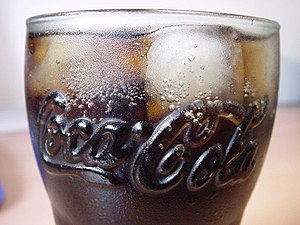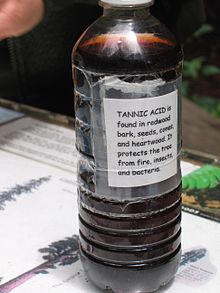The recipe for Coca-Cola remains a closely guarded trade secret.
The Coca-Cola Company's formula for Coca-Cola syrup, which bottlers combine with carbonated water to create the company's flagship cola soft drink, is a closely guarded trade secret. Company founder Asa Candler initiated the veil of secrecy that surrounds the formula in 1891 as a publicity, marketing, and intellectual property
protection strategy. While several recipes, each purporting to be the
authentic formula, have been published, the company maintains that the
actual formula remains a secret, known only to a very few select (and
anonymous) employees.
History
Vault containing the secret formula at the World of Coca-Cola in Atlanta
Coca-Cola inventor John Pemberton is known to have shared his original formula with at least four people before his death in 1888. In 1891, Asa Candler
purchased the rights to the formula from Pemberton's estate, founded
The Coca-Cola Company, and instituted the shroud of secrecy that has
since enveloped the formula. He also made changes to the ingredients
list, which by most accounts improved the flavor, and also entitled him
to claim that anyone in possession of Pemberton's original formula no
longer knew the "real" formula.
In 1919, Ernest Woodruff
led a group of investors in purchasing the company from Candler and his
family. As collateral for the acquisition loan, Woodruff placed the
only written copy of the formula in a vault at the lending bank,
Guaranty Bank in New York. In 1925, when the loan had been repaid,
Woodruff relocated the written formula to the Trust Company Bank (now SunTrust Bank) in Atlanta. On December 8, 2011, the company placed it in a vault on the grounds of the World of Coca-Cola in Atlanta, where it remains on public "display".
According to the company, only two employees are privy to the
complete formula at any given time and they are not permitted to travel
together. When one dies, the other must choose a successor within the
company and impart the secret to that person. The identity of the two
employees in possession of the secret is itself a secret.
It has been noted, however, that the company's "secret formula" policy
is more of a marketing strategy than an actual trade secret: any
competitor in possession of the genuine Coke recipe would be unable to
obtain certain key ingredients, such as processed coca leaf (see below),
and even if all components were available, could not market the
reproduced product as Coca-Cola.
Coca leaves
During the late 19th century, Coca-Cola was one of many popular coca-based
drinks with purported medicinal properties and benefits to health;
early marketing materials claimed that Coca-Cola alleviated headaches
and acted as a "brain and nerve tonic". Coca leaves were used in Coca-Cola's preparation; the small amount of cocaine they contained – along with caffeine originally sourced from kola nuts – provided the drink's "tonic" quality. In 1903, cocaine was removed, leaving caffeine as the sole stimulant ingredient, and all medicinal claims were dropped. By one account, the FDA still screens random samples of Coca-Cola syrup for the presence of cocaine.
A few sources claim that coca leaf extract, with the cocaine chemically removed, remains part of the formula as a flavoring. According to these accounts, the company obtains the ingredient from the Stepan Company
of Maywood, New Jersey, which legally extracts cocaine from coca leaves
for use in pharmaceuticals, then sells the processed leaf material for
use in Coca Cola. The company will neither confirm nor deny this, deferring to the secret nature of the formula.
In 1911, the United States government sued The Coca-Cola Company
for violations of the Pure Food and Drugs Act, claiming that the high
concentration of caffeine in Coca-Cola syrup was harmful to health. The case was decided in favor of Coca-Cola, but a portion of the decision was set aside in 1916 by the Supreme Court. As part of a settlement, the company agreed to reduce the amount of caffeine in its syrup.
Current ingredients
The
company protects the secrecy of its syrup recipe by shipping
ingredients to its syrup factories in the form of anonymous
"merchandises", numbered 1 through 9. Factory managers are told the
relative proportions of each numbered merchandise, and the mixing
procedure, but not the ingredients in the merchandises, some of which
are themselves mixtures of more basic ingredients. Merchandise no. 1 is
known to be sugar, in the form of high-fructose corn syrup or sucrose (see variations, below); caramel coloring is no. 2, caffeine is no. 3, and phosphoric acid
is no. 4. The identities of merchandises 5 through 9 are a matter of
debate – particularly "merchandise 7X" (the "X" has never been
explained), which is thought to contain a mixture of essential oils such
as orange, lime, and lemon. Another ingredient is thought to be lavender.
Despite the implications of its name, there is no evidence that the current version of Coca-Cola syrup contains kola nut extract, which was originally included for its caffeine content. The modern source of that additive is probably caffeine citrate, a byproduct of the decaffeination of coffee.
The primary taste of Coca-Cola is thought to come from vanilla and cinnamon, with trace amounts of essential oils, and spices such as nutmeg. A 2015 study identified and measured 58 aroma compounds
in common colas, confirming significant amounts of compounds
corresponding to cinnamon, vanilla, nutmeg, orange and lemon essential
oils in Coca-Cola.
Formula variations in the United States
During the 1980s, most U.S. Coca-Cola bottlers switched their primary sweetening ingredient from cane sugar (sucrose) to the cheaper high-fructose corn syrup. The only U.S. bottler still using sucrose year-round is the Coca-Cola Bottling Company of Cleveland, which serves northern Ohio and a portion of Pennsylvania.
Many bottlers outside the U.S. also continue to use sucrose as the
primary sweetener. Twelve-ounce glass bottles of sucrose-sweetened
Coca-Cola imported from Mexico are available in many U.S. markets for
those consumers who prefer the sucrose version (see "Mexican Coke",
below).
Passover
Coca-Cola was certified kosher in 1935 by Rabbi Tobias Geffen after beef tallow-derived glycerin
was replaced with vegetable glycerin. However, the high-fructose corn
syrup used by most U.S. bottlers since the 1980s renders it kitniyot by the definitions of Jewish kosher law, and therefore forbidden during Passover
according to certain traditions. Each year, in the weeks leading up to
Passover, bottlers in markets with substantial Jewish populations switch
to sucrose sweetener in order to obtain Kosher for Passover certification.
"New Coke"
In April 1985, in response to marketing research suggesting that a
majority of North American consumers preferred the taste of rival Pepsi
to Coca-Cola, the company introduced a sweeter, less effervescent
version of Coca-Cola in the U.S. and Canada. Although the new
formulation had beaten both Pepsi-Cola and the old Coke formula in
multiple blind taste tests, consumer response was overwhelmingly
negative. The company quickly reintroduced the original beverage,
rebranded as "Coca-Cola Classic", while continuing to market the new
version as "Coke".
New Coke remained on the market, in North America only, for 17
years—the last 10 as "Coke II"—until it was quietly discontinued in
2002.
The "Classic" designation remained on the original product's label, its
prominence gradually decreasing over the years, until it was removed
entirely in 2009.
Mexican Coke
In the early 2000s, cane-sugar-sweetened Coca-Cola produced in Mexico
began to appear in bodegas and Hispanic supermarkets in the Southwestern United States; in 2005, Costco
began offering it. All were obtaining the Mexican product—which was not
labeled in accordance with U.S. food labeling laws—outside the official
Coca-Cola distribution network.
In 2009, the Coca-Cola Company began officially importing Coca-Cola
produced in Mexico, with proper labeling, for distribution through
official channels.
Purported secret recipes
Pemberton recipe
Coca-Cola inventor John Pemberton is said to have written this recipe in his diary shortly before his death in 1888.
The recipe does not specify when or how the ingredients are mixed, nor
the flavoring oil quantity units of measure (though it implies that the
"Merchandise 7X" was mixed first). This was common in recipes at the
time, as it was assumed that preparers knew the method.
- Ingredients:
- 1 oz (28 g) caffeine citrate
- 3 oz (85 g) citric acid
- 1 US fl oz (30 ml) vanilla extract
- 1 US qt (946 ml) lime juice
- 2.5 oz (71 g) "flavoring", i.e., "Merchandise 7X"
- 30 lb (14 kg) sugar
- 4 US fl oz (118.3 ml) fluid extract of coca leaves (flavor essence of the coca leaf).
- 2.5 US gal (9.5 l; 2.1 imp gal) water
- caramel sufficient to give color
- "Mix caffeine acid and lime juice in 1 quart boiling water add vanilla and flavoring when cool."
- Flavoring (Merchandise 7X):
- 1 qrt alcohol
- 80 oil orange
- 40 oil cinnamon
- 120 oil lemon
- 20 oil coriander
- 40 oil nutmeg
- 40 oil neroli
- "Let stand 24 hours."
Merory recipe
Recipe is from Food Flavorings: Composition, Manufacture and Use. Makes one 1 US gallon (3.8 l; 0.83 imp gal) of syrup. Yield (used to flavor carbonated water at 1 US fl oz (30 ml) per bottle): 128 bottles, 6.5 US fl oz (190 ml).
- Mix 5 lb (2.3 kg) of sugar with just enough water to dissolve the sugar fully. (High-fructose corn syrup may be substituted for half the sugar.)
- Add 1 1⁄4 oz (35 g) of caramel, 1⁄10 oz (3 g) caffeine, and 2⁄5 oz (11 g) phosphoric acid.
- Extract the cocaine from 5⁄8 drachm (1.1 g) of coca leaf (Truxillo growth of coca preferred) with toluol; discard the cocaine extract.
- Soak the coca leaves and kola nuts (both finely powdered); 1⁄5 drachm (0.35 g) in 3⁄4 oz (21 g) of 20% alcohol.
- California white wine fortified to 20% strength was used as the soaking solution circa 1909, but Coca-Cola may have switched to a simple water/alcohol mixture.
- After soaking, discard the coca and kola and add the liquid to the syrup.
- Add 1 oz (28 g) lime juice (a former ingredient, evidently, that Coca-Cola now denies) or a substitute such as a water solution of citric acid and sodium citrate at lime-juice strength.
- Mix together
- 1⁄4 drachm (0.44 g) orange oil,
- 1⁄10 drachm (0.18 g) cassia (Chinese cinnamon) oil,
- 1⁄2 drachm (0.89 g) lemon oil, traces of
- 2⁄5 drachm (0.71 g) nutmeg oil, and, if desired, traces of
- coriander,
- neroli, and
- lavender oils.
- Add 1⁄10 oz (2.8 g) water to the oil mixture and let stand for twenty-four hours at about 60 °F (16 °C). A cloudy layer will separate.
- Take off the clear part of the liquid only and add to the syrup.
- Add 7⁄10 oz (20 g) glycerine (from vegetable source, not hog fat, so the drink can be sold to Jews and Muslims who observe their respective religion's dietary restrictions) and 3⁄10 drachm (0.53 g) of vanilla extract.
- Add water (treated with chlorine) to make a gallon of syrup.
Beal recipe
In 2011, Ira Glass announced on his Public Radio International show, This American Life, that show staffers had found a recipe in "Everett Beal's Recipe Book", reproduced in the February 28, 1979, issue of The Atlanta Journal-Constitution,
that they believed was either Pemberton's original formula for
Coca-Cola, or a version that he made either before or after the product
was first sold in 1886. The formula is very similar to the one found in
Pemberton's diary.
Coca-Cola archivist Phil Mooney acknowledged that the recipe "could be a
precursor" to the formula used in the original 1886 product, but
emphasized that the original formula is not the same as the one used in
the current product.
- Fluid extract of Coca: 3 drams USP
- Citric acid: 3 oz
- Caffeine: 1 oz
- Sugar: 30 lbs
- Water: 2.5 gal
- Lime juice: 2 pints (1 quart)
- Vanilla: 1 oz
- Caramel: 1.5 oz or more for color
The secret 7X flavor (use 2 oz of flavor to 5 gals syrup):
- Alcohol: 8 oz
- Orange oil: 20 drops
- Cinnamon oil: 10 drops
- Lemon oil: 30 drops
- Coriander oil: 5 drops
- Nutmeg oil: 10 drops
- Neroli oil: 10 drops
TV screen showing the ad formula
On January 23, 2011, in a commercial aired during the NFL Football AFC Championship Game,
Coca-Cola teased that they would share the secret formula, only to
flash a comical "formula" for a few frames. This required the use of a
video recording device to freeze on the formula for any analysis, and it
ultimately proved to be a marketing ploy with no intention of sharing
the full official formula. Ingredients listed in the commercial included
nutmeg oil, lime juice, cocoa, vanilla extract, caffeine, "flavoring",
and a smile.






